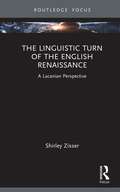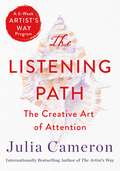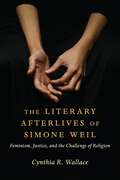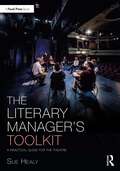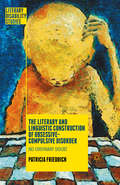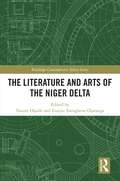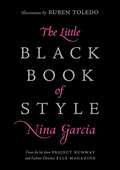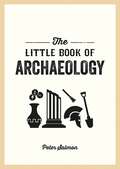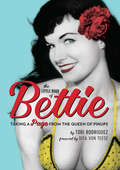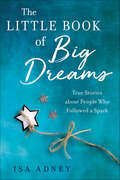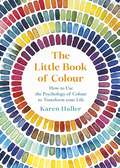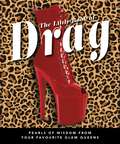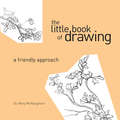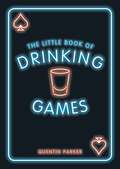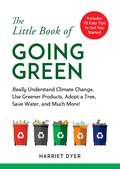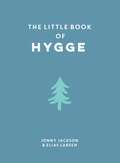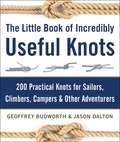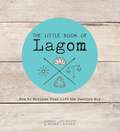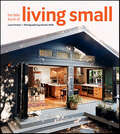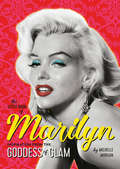- Table View
- List View
The Linguistic Turn of the English Renaissance: A Lacanian Perspective (Routledge Focus on Mental Health)
by Shirley ZisserThe Linguistic Turn of the English Renaissance: A Lacanian Perspective examines a selection of cultural phenomena of the English Renaissance, all of which include a focus on language, from a Lacanian perspective. The book examines four inter-related cultural symptoms of the English Renaissance: the paucity of painting, the interest in rhetoric, the emergence of a literary style focusing on form and a fascination with the myth of Orpheus. The book argues that the English Renaissance, an apex of rhetorical theory, can offer psychoanalysis further knowledge concerning the intrication of language and flesh, especially where feminine jouissance is at stake. These language-centred phenomena emerge against the backdrop of a peculiar configuration of the visual field, which in contrast to other cultures of the European Renaissance is largely barren of painting other than portraiture. The book will be of interest to psychoanalysts, scholars of Renaissance culture and those interested in the psychoanalytic study of culture.
The Listening Path: The Creative Art of Attention (A 6-Week Artist's Way Program)
by Julia CameronA 6-week Artist’s Way Program from legendary author Julia Cameron A Washington Post and Publisher's Weekly Bestseller"Cameron's fans will love this"—Publishers Weekly The newest book from beloved author Julia Cameron, The Listening Path is a transformational journey to deeper, more profound listening and creativity. Over six weeks, readers will be given the tools to become better listeners—to their environment, the people around them, and themselves. The reward for learning to truly listen is immense. As we learn to listen, our attention is heightened and we gain healing, insight, clarity. But above all, listening creates connections and ignites a creativity that will resonate through every aspect of our lives.Julia Cameron is the author of the explosively successful book The Artist’s Way, which has transformed the creative lives of millions of readers since it was first published. Incorporating tools from The Artist’s Way, The Listening Path offers a new method of creative and personal transformation.Each week, readers will be challenged to expand their ability to listen in a new way, beginning by listening to their environment and culminating in learning to listen to silence. These weekly practices open up a new world of connection and fulfillment. In a culture of bustle and constant sound, The Listening Path is a deeply necessary reminder of the power of truly hearing.
The Literary Afterlives of Simone Weil: Feminism, Justice, and the Challenge of Religion (Gender, Theory, and Religion)
by Cynthia R. WallaceThe French philosopher-mystic-activist Simone Weil (1909–1943) has drawn both passionate admiration and scornful dismissal since her early death and the posthumous publication of her writings. She has also provoked an extraordinary range of literary writing focused on not only her ideas but also her person: novels, nonfiction, and especially poetry. Given the challenges of Weil’s ethic of self-emptying attention, what accounts for her appeal, especially among women writers?This book tells the story of some of Weil’s most dedicated—and at points surprising—literary conversation partners, exploring why writers with varied political and religious commitments have found her thought and life so resonant. Cynthia R. Wallace considers authors who have devoted decades of attention to Weil, such as Adrienne Rich, Annie Dillard, and Mary Gordon, and who have written poetic sequences or book-length verse biographies of Weil, including Maggie Helwig, Stephanie Strickland, Kate Daniels, Sarah Klassen, Anne Carson, and Lorri Neilsen Glenn. She illuminates how writing to, of, and in the tradition of Weil has helped these writers grapple with the linked harms and possibilities of religious belief, self-giving attention, and the kind of moral seriousness required by the ethical and political crises of late modernity. The first book to trace Weil’s influence on Anglophone literature, The Literary Afterlives of Simone Weil provides new ways to understand Weil’s legacy and why her provocative wisdom continues to challenge and inspire writers and readers.
The Literary Manager's Toolkit: A Practical Guide for the Theatre (The Focal Press Toolkit Series)
by Sue HealyThe Literary Manager’s Toolkit is a clear and comprehensive guide to the role of the literary manager in theatre and beyond, focusing on the key skills, networks, and processes that underpin a successful career in this and associated roles. This book outlines the tasks and responsibilities of a literary manager in the selection, development, and production of new plays. In the first part, it outlines the how, when, and why of the literary manager’s main activities, equipping the reader with everything that they will need when approaching this role’s central challenges. The second part provides a selection of practical, accessible, and easy-to-follow materials and workshop suggestions for literary managers who will work with playwrights as they develop their creative writing and dramaturgy skills. This is the go-to resource for the working professional literary manager or dramaturg, and for students on dramaturgy courses in theatre degree programmes.
The Literary and Linguistic Construction of Obsessive-Compulsive Disorder: No Ordinary Doubt (Literary Disability Studies)
by Patricia FriedrichThis book presents a literary and linguistic reading of obsessive-compulsive disorder to argue that medical understandings of disability need their social, political, literary and linguistic counterparts, especially if we aspire to create a more inclusive, self-reflective society.
The Literature and Arts of the Niger Delta (Routledge Contemporary Africa)
by Tanure Ojaide Enajite Eseoghene OjaruegaThis book examines the depiction of the Delta region of Nigeria through literature and other cultural art forms. The Niger Delta has been thrust into the global limelight due to resource extraction and conflict, but it is also a region with a rich culture, environment, and heritage. The creative imagination of the area’s artists has been fuelled by the area’s pressing concerns of indigenous peoples, minority discourse, environmental degradation, climate change, multinational corporations' greed, dictatorship, and people’s struggle for control of their resources. Taking a holistic approach to the Niger Delta experience, this book showcases artistic responses from literature, visual arts, and performances (such as masquerades, dances, and festivals). Chapters cover authors, artists, and performers such as Ben Okri, Ken Saro-Wiwa, Isidore Okpewho, J.P. Clark, and Bruce Onobrakpeya, as well as topics like the famous Benin bronze figures and Urhobo Udje dance. Affirming the wealth and diversity of the region which continues to inspire creative artistic productions, The Literature and Arts of the Niger Delta will be of interest to researchers of African literature, arts, and other cultural productions.
The Little Black Book of Style
by Nina GarciaFrom Nina Garcia—fashion judge on Bravo’s hit Project Runway and author of Style Strategy and The One Hundred—comes her wildly popular New York Times bestseller The Little Black Book of Style. Here, in one indispensible volume, are Nina’s ultimate rules of style to help you uncover your own signature look.Every time you dress, you assert your identity. With style, you tell the world your story. In that way, style affords you opportunities to think about your appearance as a quality of your creative character. The Little Black Book of Style helps you to explore your own fashion voice—the piece of you that joyously revels in the glamorous experience of creating your best self. From cultivating good taste to guarding against definite fashion faux pas, Nina Garcia offers readers the ultimate guide to follow when it comes to dressing their best. Including tips on how and when to wear an outfit, occasion-appropriate wear, advice on how to combine colors and textures, and inspiration on how to achieve your own signature look, you learn how to experiment, storyboard, archive, and play. Timeless and universal, this book seeks to remind women that eternal style is internal style, and that everyone has what it takes to discover themselves through the colorful palette that is fashion.
The Little Book of Archaeology: A Pocket Guide to How Archaeology Works and What It Can Teach Us
by Peter SalmonPacked with fascinating facts, intriguing mysteries and breathtaking discoveries, from the ancient wonders of Egypt and Pompeii to the mysteries of lost Mayan civilizations and the enigmatic Nazca Lines in Peru, this captivating guide offers a whirlwind tour of humanity's past through the art of archaeology.
The Little Book of Archaeology: A Pocket Guide to How Archaeology Works and What It Can Teach Us
by Peter SalmonPacked with fascinating facts, intriguing mysteries and breathtaking discoveries, from the ancient wonders of Egypt and Pompeii to the mysteries of lost Mayan civilizations and the enigmatic Nazca Lines in Peru, this captivating guide offers a whirlwind tour of humanity's past through the art of archaeology.
The Little Book of Bettie: Taking a Page from the Queen of Pinups
by Dita Von Teese Tori RodriguezA lifestyle guide inspired by the Queen of Pinups -- Bettie Page -- The Little Book of Bettie offers real advice on fashion, makeup, fitness, and more for today's modern woman who loves a little dose of retro. The celebrated Queen of Pinups styled her own iconic hair, did her own makeup, fashioned her own swimsuits, and was ahead of her time in endless ways, making her a source of inspiration to stars like Madonna, Beyoncé, and Katy Perry. Against the backdrop of the conservative 1950s, Bettie Page was an advocate of pleasure, fun, liberation, and body-positivity. There's so much to be learned from her! Within The Little Book of Bettie you'll find: Bettie's remarkable backstory Retro fashion and styling tips Vintage hair and makeup lessons Bettie-inspired fitness routines DIY pinup accessory how-tos Advice from "Bettie Babes" like Dita Von Teese, modern-day pinups and entertainers, and everyday women who love Bettie! Filled with both color and black-and-white images, The Little Book of Bettie is a beautifully gifty, celebratory look at the groundbreaking style of one of the greatest icons of pop culture.
The Little Book of Big Dreams: True Stories about People Who Followed a Spark
by Isa AdneySometimes, dreams do come true.There’s a lot of advice out there about how to pursue your goals, but sometimes all a dreamer needs to keep going is a true story of a dream becoming reality: proof that lows are a normal part of the process, and hope that all your hard work might still have a chance of paying off.The Little Book of Big Dreams is filled with true stories of dreamers just like you who dared to reach for the stars and actually go for the things they wanted most in life—but the most important story in this book is yours. Each uplifting tale in these pages is meant to inspire you along your dream journey, not only helping you keep going when things get hard but also reminding you that obstacles don’t mean you’re doing this wrong—they mean you’re on your way.The dreamers in this book include Oscar winner Kristen Anderson-Lopez, Disney producer Don Hahn, Pensole Lewis College founder D’Wayne Edwards, Hamilton cast member Seth Stewart, Black Girls Code founder Kimberly Bryant, actor and filmmaker Justin Baldoni, and more.
The Little Book of Colour: How to Use the Psychology of Colour to Transform Your Life
by Karen HallerA SUNDAY TIMES DESIGN BOOK OF THE YEAR_________________________________________The definitive guide for harnessing the power of colour to improve your happiness, wellbeing and confidenceWouldn't you like to boost your confidence simply by slipping on 'that' yellow jumper? Or when you get home after a stressful day, be instantly soothed by the restful green of your walls?The colours all around us hold an emotional energy. Applied Colour Psychology specialist, Karen Haller, explains the inherent power of colour; for example, looking closely at the colours we love or those we dislike can bring up deeply buried memories and with them powerful feelings. A revolutionary guide to boosting your wellbeing, The Little Book of Colour puts you firmly in the driver's seat and on the road to changing the colours in your world to revamp your mood and motivation. Illuminating the science, psychology and emotional significance of colour, with key assessments for finding your own true colour compatibility, this book will help you to rediscover meaning in everything you do through the joy of colour.Get ready to join the colour revolution, and change your life for the better.
The Little Book of Drag (The\little Book Of... Ser.)
by Orange Hippo!Drag may have been around for hundreds of years, but it's only in recent years that it's really hit the mainstream. Thanks in part to the phenomenon that is RuPaul's Drag Race, drag is now a regular feature of TV, streaming, podcasts and more, and it is beloved by many – stars such as Bianca Del Rio and Trixie Mattel are now household names. But that growing fame hasn't been entirely positive, with backlash from conservatives and religious groups.The Little Book of Drag is a sickening celebration of all things drag, serving realness with facts, history and quotes from the queens. Providing all the T on everything you've ever wanted to know, this is the book for any queen who wants to get reading . . . the library is open.
The Little Book of Drag (The\little Book Of... Ser.)
by Orange Hippo!Drag may have been around for hundreds of years, but it's only in recent years that it's really hit the mainstream. Thanks in part to the phenomenon that is RuPaul's Drag Race, drag is now a regular feature of TV, streaming, podcasts and more, and it is beloved by many – stars such as Bianca Del Rio and Trixie Mattel are now household names. But that growing fame hasn't been entirely positive, with backlash from conservatives and religious groups.The Little Book of Drag is a sickening celebration of all things drag, serving realness with facts, history and quotes from the queens. Providing all the T on everything you've ever wanted to know, this is the book for any queen who wants to get reading . . . the library is open.
The Little Book of Drawing: A Friendly Approach
by Mary McnaughtonThe drawing book for everyone.What happened? As kids, we were all artists. After all, it doesn't take much: a pencil, some paper, a few minutes at a time and the basic concepts illustrated in The Little Book of Drawing. This book is the friendly little reminder that anyone can draw and draw well. Dr. Mary McNaughton's unique, friendly approach will help you rediscover art and develop that creative voice within you.Covers all the fundamental concepts and techniques—stuff like contour and gesture drawing, the importance of value, how to build strong compositions and finding good subjects.Provides engaging exercises challenge you to take your art to the next level by drawing with your other hand, working in series, turning your name into art, and other friendly exercises.Helps you apply what you've learned and explore your own unique style in a series of drawing projects that range from gardens and landscapes to animals and the human figure.The Little Book of Drawing gives you enough direction to get you going, yet not so much that you feel overwhelmed or frustrated. The steps are little, but the results are big.
The Little Book of Drinking Games: The Weirdest, Most-Fun and Best-Loved Party Games from Around the World
by Quentin ParkerLiven up the party with this heady collection of drinking games! Choose from brain-boggling classics such as Fuzzy Duck and Twenty-One or dizzying games of pure chance like TV Drinking and Vodka Roulette – whichever you play, you’re guaranteed to be gleeful and giggly by the end!
The Little Book of Drinking Games: The Weirdest, Most-Fun and Best-Loved Party Games from Around the World
by Quentin ParkerLiven up the party with this heady collection of drinking games! Choose from brain-boggling classics such as Fuzzy Duck and Twenty-One or dizzying games of pure chance like TV Drinking and Vodka Roulette – whichever you play, you’re guaranteed to be gleeful and giggly by the end!
The Little Book of Going Green: Really Understand Climate Change, Use Greener Products, Adopt a Tree, Save Water, and Much More! (The\little Book Of Ser.)
by Harriet Dyer“We have forgotten how to be good guests, how to walk lightly on the earth as its other creatures do.” —Barbara Wood The Little Book of Going Green aims to shed light on the ways humans are harming the environment, from pollution and deforestation to industrial production and farming methods. Before we can fix a problem, we must have a basic understanding of what brought us there in first place. Dyer explores past events and actions before directing our attention to the future through the exploration of how climate change has been affected by:PlasticsFossil FuelsIndustrial AgricultureDeforestationHuman Population In addition, Dyer explores how we can easily practice sustainability and conservation on both individual and corporate levels, creating habits at home that we can then bring to our workplaces. How can we reduce plastic waste in our homes? How can we reduce our carbon footprint in the office? Filled with facts, theories, and tips on how we can do our bit for the planet, this is your one-stop guide to making every aspect of your life earth-friendly.
The Little Book of Hygge
by Jonny Jackson Elias LarsenHygge – the now familiar Danish word for warmth, cosiness, peace and harmony – is something we all aspire to. This charming little book, filled with comforting quotes and simple tips, will help you kindle this cosiness in your own life. Light a candle, snuggle up and celebrate the things that make life good.
The Little Book of Hygge
by Jonny Jackson Elias LarsenHygge – the now familiar Danish word for warmth, cosiness, peace and harmony – is something we all aspire to. This charming little book, filled with comforting quotes and simple tips, will help you kindle this cosiness in your own life. Light a candle, snuggle up and celebrate the things that make life good.
The Little Book of Incredibly Useful Knots: 200 Practical Knots for Sailors, Climbers, Campers & Other Adventurers
by Geoffrey Budworth Jason DaltonLearn to apply the right knot for any situation-a guide for the home, backpack, or boat.The fundamental skill of tying knots is useful in countless situations, both indoors and out. The Little Book of Incredibly Useful Knots teaches you which knot to choose and exactly how to tie it, whether you’re constructing a trout fly, repairing a hammock, mooring a boat, securing a load to a car roof rack, or engaging in a rescue or survival situation.Compiled and written by two experts on the subject, this is an invaluable manual that explains through clear line diagrams and step-by-step descriptions how to tie more than two hundred practical knots, grouped by construction and tying method. Every entry contains a brief introduction to the history and development of the knot, its alternative names, and information on its uses and special features. Types of knots detailed include:Wagoner’s hitchEnglishman’s loopScaffold knotCordelette anchorTrident loopLobster buoy hitchThe book also contains a comprehensive glossary of terms to guide you through the complexities of different rope types. It helps you choose the right rope for every task.Skyhorse Publishing is proud to publish a broad range of books for fishermen. Our books for anglers include titles that focus on fly fishing, bait fishing, fly-casting, spin casting, deep sea fishing, and surf fishing. Our books offer both practical advice on tackle, techniques, knots, and more, as well as lyrical prose on fishing for bass, trout, salmon, crappie, baitfish, catfish, and more. While not every title we publish becomes a New York Times bestseller or a national bestseller, we are committed to publishing books on subjects that are sometimes overlooked by other publishers and to authors whose work might not otherwise find a home.
The Little Book of Lagom: How to Balance Your Life the Swedish Way
by Jonny Jackson Elias LarsenLagom (pronounced lah-gom) is a Swedish word that means ‘not too much and not too little but just the right amount’. It’s about achieving a happy and healthy balance in all aspects of your life, setting realistic goals and living within your means. Be kind to yourself and simplify your life. Think Lagom.
The Little Book of Living Small
by Laura FentonThe Little Book of Living Small offers practical, everyday advice for managing a tight footprint. It features twelve case study homes in which style-savvy, small-space dwellers (from singles to families of four) open their doors and share their design secrets. Stylistically these homes range from urban to rural, minimalist to bohemian, with the unifying thread that they are all real homes of 1,200 square feet or less and offer clever solutions for you to use in your own home. Highly engaging with lists, tips, and actionable advice, The Little Book of Living Small shows readers how to make the most of limited square footage—with grace and style—and serves as the cheerleader readers need to help themselves feel satisfied and proud of their choice to live with less.
The Little Book of Marilyn: Inspiration from the Goddess of Glam
by Michelle MorganA lifestyle guide and tribute to the style, glamour, and showmanship of Hollywood's most iconic star, with Marilyn-inspired lessons and inspiration for today's woman.While the 1950s was in many ways an era of repression for women, Marilyn Monroe broke barriers and rebelled against convention -- and charmed the world with her beauty, talent, and irresistible personality. Filled with gorgeous photos, The Little Book of Marilyn will show you how to bring a touch of that glamour into your own life through: Tutorials on recreating the star's makeup looks Style advice and tips on where to find Marilyn-like fashions Décor ideas from Marilyn's own homes Everyday inspiration from her life that will let your inner Marilyn shine, and much more!
The Little Book of Natural Cleaning
by SphereHome is where the heart is... Home is the place where everyone should feel happy and at peace . . . and that means a house that is clean, safe and welcoming to all.Using traditional, natural cleaning methods to tackle everyday chores is not only a simple and effective way to help the environment, but also helps safeguard your family, friends and pets from germs and the potentially harmful side-effects of many modern cleaning products.THE LITTLE BOOK OF NATURAL CLEANING contains everything you need to know about cleaning with easy-to-find and inexpensive natural ingredients like lemons, bicarbonate of soda and white vinegar. Your home will soon be fresh, clean and safe for all the family.And whilst you #StayHome, don't miss these other great titles from Sphere Books: ** Distract Yourself: 101 Positive Things to Do and Learn Whilst You Stay Home **** The Bumper Book of Would You Rather? Over 350 hilarious hypothetical questions for ages 6 to 106 **** AA British Road Map Puzzle Book: Addictive map-based brain-games for anyone in lockdown ** ** Shelf Respect: A Book Lovers' Guide to Curating Book Shelves at Home **
